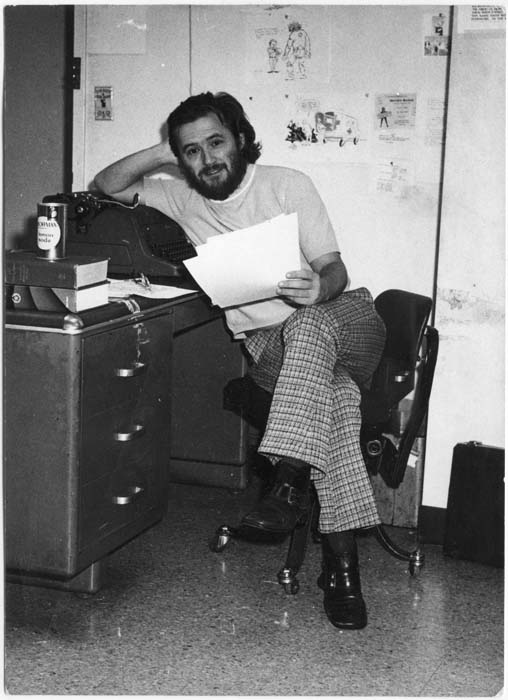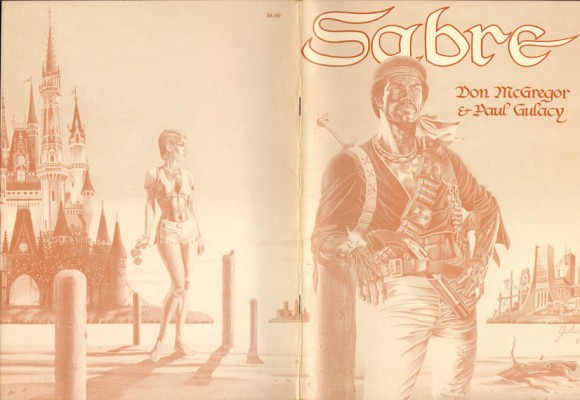The veteran comics writer has a lot to say about his time with the House of Ideas — and how he ended up publishing the legendary noir series Detectives Inc. Here’s Part 2 of a three-part special Sunday series:
Adapted from an excerpt from McGregor’s long-form essay Investigating Detectives Inc. One more excerpt will run next Sunday. Part 1 can be found here. Copyright 2014, Don McGregor.
By DON MCGREGOR
In 1978, I was working on a couple of scripts for the Black & White comic titles Marvel was putting out. One of them was a realistic police procedural featuring a character I had created when I was doing Luke Cage, Power Man: Quentin Chase.
It was titled, “A Touch of Euphoria, A Touch of Death.”
I had found, after working on the first Sabre graphic novel, that interracial elements could still bring fire to the eyes of certain folks. Somehow fire, and voiced threats.
Racist ideologies of various degrees did not belong exclusively to editorial edicts, but could unexpectedly appear on the other side of getting a comic done.
I had thought that well into the late ’70s we were past all the rabid, miscegenation taboos; but I began to realize I was living in Manhattan and environs and that the attitude I took for granted, was anything but.
One editor I had been dealing with was appalled that part of the Quentin Chase story dealt with the marriage of a black woman and a white man.
Sitting in his office, after he had read the complete synopsis, the editor spoke quietly and sincerely, so he would not be heard in the outer bullpen. “I can’t believe you would put in this mixture stuff. It makes me sick to think of all those beautiful Nordic blonde women having their blood tainted. You need to think, Don, of all those races losing their ethnic purity.”
He wasn’t joking.
At first, I had trouble believing I was hearing what I was hearing.
To this day it somewhat mystifies me why he would say such things to me. After all, I was the writer who had created the Panther vs. the Klan storyline. I had maneuvered a way to do the first interracial kiss at Marvel with Killraven. And Sabre went everywhere none of those comics could ever have gone in the mid-’70s. So why would he be so blatant in his racism?
I can only surmise that it was so horrifyingly jolting to him that he could not control these inner-held beliefs.
I insisted that the married couple in “A Touch of Euphoria, A Touch of Death” remain interracial, since that was a major reason I had wanted to write that story – to show we have not come as far as we may think, and that often we make innocent people pay a price in suffering that gets higher all the time.
I know there are some comic fans that don’t want to read that such attitudes existed.
I know there are others that will never admit it plays to their own prejudices. But it is a part of the history of comics, and what dictated for so long what could get into the comics.
And could not.
I had to live through this as a human being and a writer. And the choices you make you will have to live with, you can’t gloss over.
Marshall Rogers’ name had been mentioned as a possible artist for this Quentin Chase piece, which was being considered as a possible on-going series. I was ecstatic about that. Marshall was just coming off his famous run on the Batman with Steve Englehart, and the noirish mood of the story would fit him perfectly. When Marshall’s name was suggested, there was a part of me that thought this was almost too good to be true.
I could not believe, before this descent into “Nordic blondes” and “ethnic purity”, that when I had told them the preliminary ideas for the story would touch on child pornography, interracial marriage, miscarriage, and drugs that anyone at Marvel would have given it any kind of green light.
Plus, they had given me the go-ahead to do a new Hodiah Twist story, too.
I did not want to return to the continuous grind of scripting series comics at the expense of not having time to do other work – especially the novel I was writing, “An Erotic Priority” – but if I could do a few select stories to help stay alive while working on my own projects, and if they were stories I truly wanted to do, stories that the editors themselves liked, and that we were all in accord … well, this could be a heavenly working situation. I’d take it a day – and a story – at a time. Once burned, and all that.
During the time I was writing the Hodiah Twist story, “The Hero Killer Principle,” Marsha and I were married (after a series of incidents, including Marsha’s mom breaking her arm just before the wedding, that were almost as surreal as anything Hodiah was going through.)
I wrote a full script for “The Hero Killer Principle,” as opposed to the 34-page plot synopsis I had done for “A Touch of Euphoria, A Touch of Death.” That’s right. 34 pages!
The story was detailed in every way so no one would have unanswered questions of what the story would deal with. I had written Chase as an in-depth plot as I wrote the finished script for the Hodiah Twist story. With the marriage upcoming, I was so desperate for cash that I’d sold them that elaborate plot for the Quentin Chase piece for only $50.
All that work. $50.
Of course, it was understood I would script it as soon as they assigned an artist and the penciled pages came in. Whenever that would be.
Heaven did not last long.
Since editors many times are not autonomous in comics, they have others beside themselves or over them who can dictate what can happen to your script.
Now, suddenly, they wanted the interracial marriage gone, they wanted pages cut out of the story, pages too important to what the story was about and to the characters within it.
When I realized how serious the implications were as this conversation quietly unfolded with its blatant racism, I said, “No hard feelings now, but this is a story I really want to do, and I have put it precisely the way I want to present it. If it can’t be done that way, let me buy it back from you at the fifty dollars, and I’ll do it somewhere else.”
The editor shook his head. His eyes were puzzled, as if I were some alien creature he could not fathom. It almost seemed as if it were beyond his ken that a writer would not want to do their story with them.
“You can’t be serious.”
I was.
I immediately started to work on finding another publisher. I called Dean Mullaney of Eclipse Enterprises, and told him I would need fifty dollars to buy the plot back, and that I would transform it into a Detectives Inc. script.
I had talked with Dean, probably even before we did Sabre, about Detectives Inc. and Ragamuffins. I just could not go into the unknown direct marketplace with a non-costumed hero series. Dean was well aware of Denning and Rainer.
“Is that OK?” I asked.
“Go ahead,” Dean said.
And that’s when I suggested we get Marshall Rogers to be the artist for Detectives Inc for Eclipse.
NEXT WEEK: Sometimes a plan comes together.



